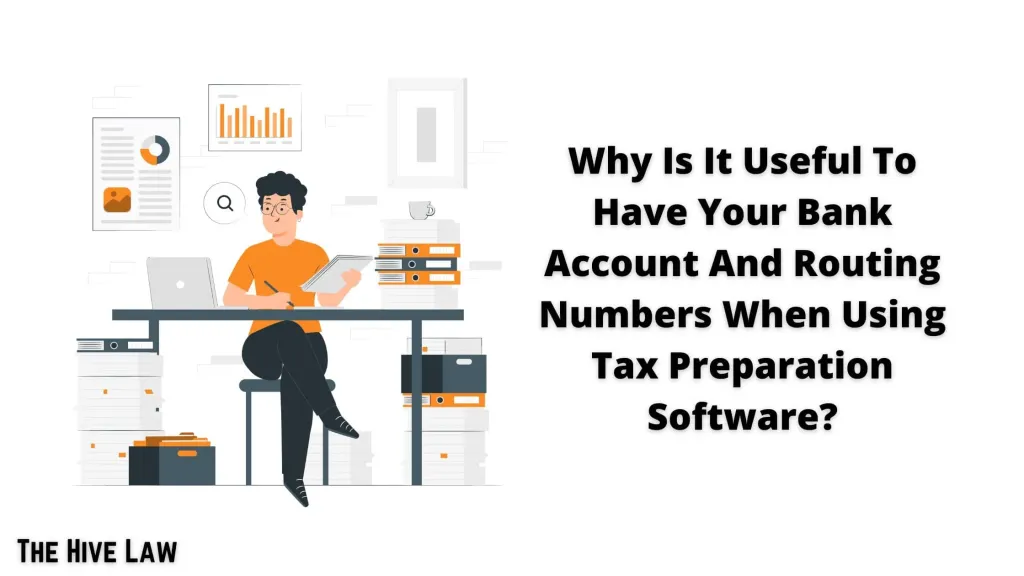Tax season can be a stressful time for many, with the pressures of ensuring accuracy, meeting deadlines, and maximizing refunds. Fortunately, tax preparation software has made the process more manageable, providing user-friendly interfaces, automated calculations, and helpful guidance. Among the many pieces of information required during the tax filing process, your bank account and routing numbers stand out as particularly important. In this article, we’ll explore why having these numbers on hand can significantly enhance your tax preparation experience.
The Role of Bank Account and Routing Numbers in Tax Preparation
1. Facilitating Direct Deposit of Refunds
One of the primary reasons for having your bank account and routing numbers ready when using tax preparation software is to facilitate the direct deposit of your tax refund. Direct deposit is the fastest way to receive your refund. Here’s why it’s beneficial:
- Speed: Direct deposits are typically processed much faster than paper checks. While a paper check can take weeks to arrive, direct deposits are usually completed within a few days after the IRS processes your return.
- Convenience: With direct deposit, there’s no need to worry about losing a check in the mail or making a trip to the bank to deposit it. The money goes straight into your account.
- Security: Direct deposit reduces the risk of your refund being lost or stolen. It’s a secure method as your information is transmitted electronically.
2. Paying Taxes Owed Electronically
If you owe taxes, having your bank account and routing numbers ready can simplify the payment process. Many tax preparation software programs allow you to pay any taxes due electronically, directly from your bank account. This method has several advantages:
- Immediate Processing: Electronic payments are processed more quickly than mailing a check, ensuring that your payment is received by the IRS promptly.
- Avoiding Late Fees: By paying electronically, you can schedule your payment to ensure it’s made on time, helping you avoid potential late fees and interest charges.
- Record Keeping: Electronic payments provide an immediate record of your transaction, which can be useful for your personal records and for any future tax-related inquiries.
3. Setting Up Automatic Installment Payments
For those who cannot pay their taxes in full by the due date, the IRS offers installment agreements. Tax preparation software often allows you to set up these agreements directly, using your bank account information to arrange automatic monthly payments. The benefits of this feature include:
- Ease of Setup: Setting up an installment agreement through your tax software is straightforward and can often be done at the time of filing.
- Consistency: Automatic payments ensure that you make consistent, timely payments, helping you stay on track with your agreement and avoid penalties.
- Flexibility: You can often adjust the payment amount and date to suit your financial situation, making it easier to manage your finances.
4. Ensuring Accuracy and Reducing Errors
Entering your bank account and routing numbers correctly is crucial for avoiding errors that can delay your refund or payment. Tax preparation software often includes validation checks to ensure that the information you provide is accurate. This can help:
- Prevent Mistakes: The software can flag potential errors, such as incorrect routing numbers, before you submit your return.
- Reduce Delays: Accurate bank information ensures that your direct deposit or electronic payment is processed without unnecessary delays.
- Enhance Security: Accurate entry reduces the risk of funds being misdirected or lost.
5. Simplifying Future Tax Preparations
Many tax preparation software programs allow you to save your bank account and routing information securely for future use. This feature simplifies the tax filing process in subsequent years by:
- Saving Time: You won’t need to re-enter your banking information each year, saving time and reducing the hassle.
- Ensuring Consistency: Using the same bank account information consistently can help streamline your tax preparation and ensure accuracy.
- Providing Continuity: If you use the same software year after year, having your information saved can make the transition from one tax season to the next seamless.
Frequently Asked Questions (FAQ)
How do I find my bank account and routing numbers?
Your bank account and routing numbers can be found on the bottom of your checks. The routing number is the first set of numbers on the left, followed by your account number. You can also find these numbers by logging into your online banking account or contacting your bank directly.
Is it safe to enter my bank account and routing numbers into tax preparation software?
Reputable tax preparation software uses advanced encryption and security measures to protect your personal information, including your bank account and routing numbers. Ensure you are using a trusted and well-reviewed software to minimize any risks.
What should I do if I enter the wrong bank account or routing number?
If you realize that you’ve entered incorrect banking information after submitting your return, contact the IRS as soon as possible to correct the error. You may also need to contact your bank to alert them to the mistake. In some cases, the IRS may issue a paper check if the direct deposit fails.
Can I split my refund into multiple accounts?
Yes, the IRS allows taxpayers to split their refunds into up to three different bank accounts. This can be done by filling out Form 8888, Allocation of Refund (Including Savings Bond Purchases), and providing the necessary banking information for each account.
What if I don’t have a bank account?
If you don’t have a bank account, you can still receive your tax refund by mail as a paper check. However, this method is slower and may be less secure than direct deposit. Alternatively, you can consider opening a bank account or using a prepaid debit card that accepts direct deposits.
Are there fees associated with electronic payments?
While the IRS does not charge a fee for direct debit payments, your bank may charge a fee for electronic fund transfers. Additionally, if you use a credit or debit card to pay your taxes through a third-party processor, there may be associated fees. Always check with your bank or payment processor for specific fee information.
Can I change my direct deposit information after filing my return?
Once your return has been filed and accepted by the IRS, you generally cannot change your direct deposit information. If your bank account is closed or the information is incorrect, the IRS will issue a paper check instead. To avoid issues, double-check your banking information before submitting your return.
How long does it take to receive a refund via direct deposit?
The IRS issues most refunds within 21 days of processing your return, provided there are no errors or issues that require further review. Direct deposits are typically faster than paper checks, which can take several weeks to arrive.
Can I use my bank account and routing numbers for state tax refunds?
Yes, most states that offer tax refunds allow you to use direct deposit by providing your bank account and routing numbers. The process is similar to that of the federal return and can expedite the receipt of your state tax refund.
Conclusion
Having your bank account and routing numbers ready when using tax preparation software is not only convenient but also essential for a smooth and efficient tax filing process. Whether you are expecting a refund, need to pay taxes owed, or want to set up an installment agreement, providing accurate banking information can save you time, reduce the risk of errors, and enhance the overall security of your transactions.
By understanding the importance of these numbers and following the best practices for their use, you can make the most of your tax preparation software and ensure a hassle-free tax season. Whether you are a seasoned filer or a first-time user, being prepared with your bank account and routing numbers can make a significant difference in your tax filing experience.


